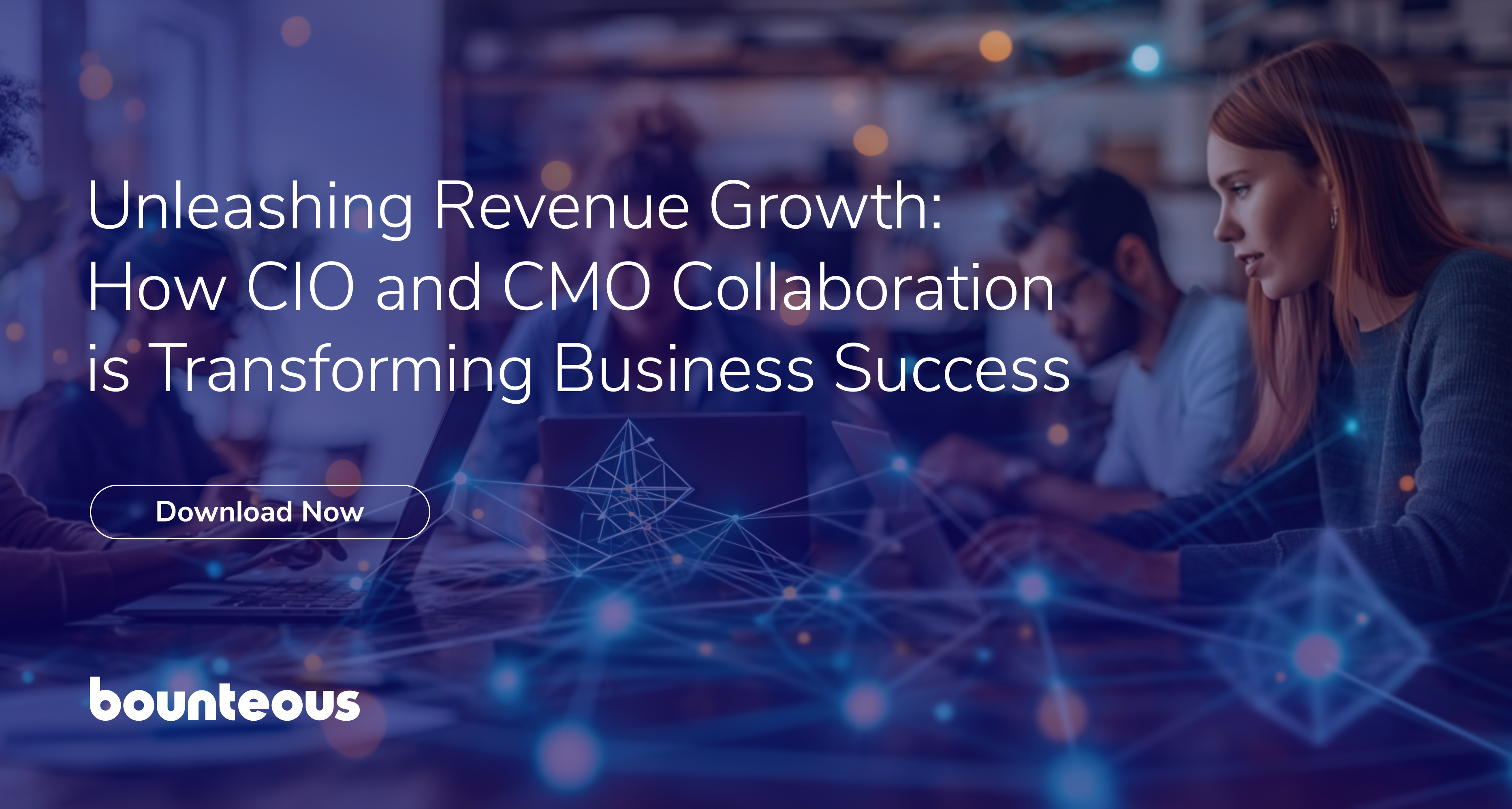Unleashing Revenue Growth: How CIO and CMO Collaboration is Transforming Business Success

Historically, CIOs and CMOs have worked in silos – the CIO on IT systems management and the CMO on marketing, brand-building, and growth. The lines are now blurring, bringing about the need for stronger alignment between these roles and their organizations.
Through a series of Bounteous-led and commissioned surveys, we found that both roles are driven by three common goals and priorities: improving customer experiences, facilitating operational efficiency, and increasing revenue. Bottom line: CIOs and CMOs need to break down silos within their organizations and collaborate to be successful.
In our recent whitepaper, we examine what CIOs and CMOs need to do to meet these goals and priorities, and recommend the following:
- Organizations must transform quickly in order to remain relevant and ahead of the competition.
- CIOs and CMOs agree:
- According to a commissioned Bounteous report, the key measure of digital transformation success is improved customer experience.
- AI is the biggest area of investment and focus for their teams.
- Increased collaboration among teams would significantly improve AI adoption.
- To fully leverage advanced technologies, CIOs and CMOs must collaborate.
- Continual investment in digital transformation gives companies the agility to meet rapidly evolving customer expectations.
- Preeminent companies bring in co-innovation partners to strengthen internal collaboration and unify digital transformation strategies.
The traditional boundaries separating CIOs and CMOs are dissolving, necessitating a more integrated approach to drive organizational success.
#1 Priority: Improving the Customer Experience
According to Forrester, companies that prioritize customer experience generate 5.7 times more revenue than their less customer-centric counterparts. Customer obsession isn’t just a cultural mindset – it’s a strategic growth engine.
Collaboration across teams is key to revenue growth. By actively sharing insights from customer interviews, win/loss analysis, and other feedback, organizations can make informed decisions that enhance marketing messaging, product development, and service delivery.
Establishing regular cross-functional touchpoints is crucial for reviewing findings, aligning priorities, and tracking actions. This approach emphasizes that customer experience is a shared priority across the organization, not just a departmental initiative. It requires leadership to drive a cultural shift that focuses on customer-centricity and empowers employees to take ownership of the customer experience. Additionally, developing a long-term vision for customer experience and aligning it with overall business goals and strategies ensures that every facet of the organization is coordinated toward delivering exceptional value to customers.
Collaboration plays a vital role in ensuring a unified customer journey, enabling proactive problem-solving, promoting consistent messaging, and increasing agility when adapting to customer needs. By aligning IT and marketing efforts, organizations can foster a culture of knowledge sharing where every team places the customer experience at the forefront of their priorities. This synergy not only enhances operational efficiency but also ensures that the organization speaks with one voice, creating a seamless experience for customers.
Research conducted by Salesforce finds that 80% of customers believe the experience a company provides is as crucial as its products or services. This highlights the rising expectations of consumers and the need for organizations to prioritize customer experience at every level.
Through a committed and collaborative approach, organizations can deliver exceptional experiences that not only meet customer needs but also drive sustained revenue growth, solidifying their position as leaders in customer-centric strategies.
Prioritizing Customer Experience
As new processes and technologies are introduced, it’s imperative for CIOs and CMOs to keep customer experience top-of-mind. This will not only foster a sense of accountability but also drive continuous improvement throughout the organization.
Prioritizing customer experience reinforces a culture that is truly obsessed with meeting and exceeding customer expectations, where insights fuel actual change. This approach enhances customer satisfaction and drives revenue growth by ensuring that every decision made aligns with the needs and desires of the customer.
By focusing on these key areas, CIOs and CMOs can lead their organizations toward a more customer-centric future, leveraging technology and innovation to create lasting value.
Why Bounteous
To keep their companies on the forefront of digital transformation, leading executives seek out third-party service providers like Bounteous to work with them as partners.
Download our whitepaper, “Stronger Together: CIOs and CMOs Must Align to Win,” to learn more about the challenges CIOs and CMOs are facing, and how we can help you build blended teams that collaborate and resolve obstacles.


